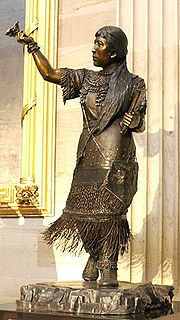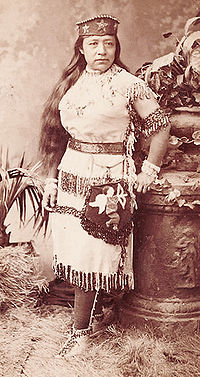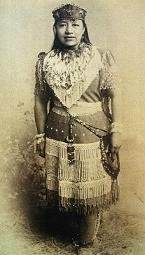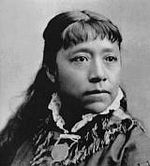
Sarah Winnemucca
Encyclopedia

Circa
Circa , usually abbreviated c. or ca. , means "approximately" in the English language, usually referring to a date...
1844 – October 17, 1891) was a prominent female Native American activist and educator, and an influential figure in the United States' nineteenth-century Indian policies. Winnemucca was notable for being the first Native American
Native Americans in the United States
Native Americans in the United States are the indigenous peoples in North America within the boundaries of the present-day continental United States, parts of Alaska, and the island state of Hawaii. They are composed of numerous, distinct tribes, states, and ethnic groups, many of which survive as...
woman known to secure a copyright and to publish in the English language
English language
English is a West Germanic language that arose in the Anglo-Saxon kingdoms of England and spread into what was to become south-east Scotland under the influence of the Anglian medieval kingdom of Northumbria...
. She was also known by her married name, Sarah Winnemucca Hopkins, under which she was published. Her book, Life Among the Paiutes: Their Wrongs and Claims, is an autobiographical account of her people during their first forty years of contact with explorers and settlers.
Sarah was a person of two worlds. At the time of her birth her people had only very limited contact with Euro-Americans; however she spent much of her adult life in white society. Like many people of two worlds, she may be judged harshly in both contexts. Many Paiutes view her as a collaborator who helped the U.S. Army kill her people. Modern historians view her book as an important primary source, but one that is deliberately misleading in many instances. Despite this, Sarah has recently received much positive attention for her activism. She was inducted into the Nevada Writers Hall of Fame in 1993, and in 2005 a statue of her by sculptor Benjamin Victor was added to the National Statuary Hall Collection
National Statuary Hall Collection
The National Statuary Hall Collection in the United States Capitol comprises statues donated by individual states to honor persons notable in their history...
in the U.S. Capitol.
Early life

Humboldt Sink
Humboldt Sink is an intermittent dry lake bed, approximately 11 mi long, and 4 mi across, in northwestern Nevada in the United States...
in what is now western Nevada
Nevada
Nevada is a state in the western, mountain west, and southwestern regions of the United States. With an area of and a population of about 2.7 million, it is the 7th-largest and 35th-most populous state. Over two-thirds of Nevada's people live in the Las Vegas metropolitan area, which contains its...
, Sarah Winnemucca was the daughter of Chief Winnemucca
Chief Winnemucca
Winnemucca, , was born a Shoshoni around 1820 in what would later become the Oregon Territory. He married a Kuyuidika woman, the daughter of Old Winnemucca, and thus was a Paiute himself by tribal rules...
(Poito) and Tuboitonie. Although she claimed that her father was chief of all the Northern Paiute
Paiute
Paiute refers to three closely related groups of Native Americans — the Northern Paiute of California, Idaho, Nevada and Oregon; the Owens Valley Paiute of California and Nevada; and the Southern Paiute of Arizona, southeastern California and Nevada, and Utah.-Origin of name:The origin of...
(and she was therefore often called the "Paiute Princess" by the press), the Paiute had no centralized leadership and her father, though influential, was the leader of a small band.
Sarah's grandfather, Tru-ki-zo or Truckee
Truckee (chief)
Truckee was medicine chief of the Northern Paiute and an influential prophet.-Family life:...
(meaning "good" in the Paiute language), was enthusiastically friendly towards white people. Some say that he was called "Truckee" because it means "good" in the Paiute language, while others say that he got his name because he shouted "Tro-kay" which means "hello." He guided John C. Frémont
John C. Frémont
John Charles Frémont , was an American military officer, explorer, and the first candidate of the anti-slavery Republican Party for the office of President of the United States. During the 1840s, that era's penny press accorded Frémont the sobriquet The Pathfinder...
during his 1843–45 survey and map-making expedition across the Great Basin
Great Basin
The Great Basin is the largest area of contiguous endorheic watersheds in North America and is noted for its arid conditions and Basin and Range topography that varies from the North American low point at Badwater Basin to the highest point of the contiguous United States, less than away at the...
to California. Later he fought in the Mexican-American War, earning many white friends. Although Sarah was initially terrified of white people, her grandfather took her with him on a trip to the Sacramento
Sacramento, California
Sacramento is the capital city of the U.S. state of California and the county seat of Sacramento County. It is located at the confluence of the Sacramento River and the American River in the northern portion of California's expansive Central Valley. With a population of 466,488 at the 2010 census,...
area (a trip her father refused to make), and later placed her in the household of William Ormsby
William Ormsby
William Matthew Ormsby was an early settler of Nevada who was instrumental in the establishment of Carson City and the Nevada Territory. Major Ormsby was killed leading a vigilante force against Paiute Indians near Pyramid Lake.-Early Life:...
of Carson City, Nevada
Carson City, Nevada
The Consolidated Municipality of Carson City is the capital of the state of Nevada. The words Consolidated Municipality refer to a series of changes in 1969 which abolished Ormsby County and merged all the settlements contained within its borders into Carson City. Since that time Carson City has...
to be educated. Sarah Winnemucca soon became one of very few Paiutes in Nevada able to read and write English.
William Ormsby was later killed in action at the first battle of the Paiute War
Paiute War
The Paiute War, also known as the Pyramid Lake War, Washoe Indian War and the Pah Ute War, was an armed conflict between Northern Paiutes allied with the Shoshone and the Bannock against the United States. It took place in 1860 in the vicinity of Pyramid Lake in the Utah Territory, now within...
when the militia force he led was annihilated by a Paiute force led by Sarah's cousin Numaga. Sarah's book tells how her brother Natchez unsuccessfully tried to save Ormsby by faking his death. Her father and brother both fought on the Paiute side.
After the war, Sarah's family moved to the Malheur Reservation
Malheur Reservation
The Malheur Reservation was an Indian reservation in the U.S. state of Oregon from 1872 to 1879.-Establishment:On September 12, 1872, a presidential order set aside the Malheur Indian Reservation in Eastern Oregon for the Northern Paiute...
which was designated a reservation for the Northern Paiute and Bannock
Bannock (tribe)
The Bannock tribe of the Northern Paiute are an indigenous people of the Great Basin. Their traditional lands include southeastern Oregon, southeastern Idaho, western Wyoming, and southwestern Montana...
by a series of Executive Orders issued by President Ulysses S. Grant
Ulysses S. Grant
Ulysses S. Grant was the 18th President of the United States as well as military commander during the Civil War and post-war Reconstruction periods. Under Grant's command, the Union Army defeated the Confederate military and ended the Confederate States of America...
. Sarah taught in a local school and acted as interpreter for Indian Agent
Indian agent
In United States history, an Indian agent was an individual authorized to interact with Native American tribes on behalf of the U.S. government.-Indian agents:*Leander Clark was agent for the Sac and Fox in Iowa beginning in 1866....
Samuel Parrish. Parrish worked well with the Paiute, and established a coherent and well-managed agricultural program.
Bannock War
After four years, Parrish was replaced by agent William Rinehart. He failed to pay Paiute workers for agricultural labor in commonly held fields, and alienated many tribal leaders. Conditions at the Malheur Reservation quickly became intolerable. Sarah's book tells how the Indian Agent sold many of the supplies intended for the people to local whites. Much of the good land on the reservation was also illegally expropriated by white settlers. In 1878 virtually all of the people on the reservation left it. The Bannock who left began raiding isolated white settlements in southern OregonOregon
Oregon is a state in the Pacific Northwest region of the United States. It is located on the Pacific coast, with Washington to the north, California to the south, Nevada on the southeast and Idaho to the east. The Columbia and Snake rivers delineate much of Oregon's northern and eastern...
and Northern Nevada, triggering the Bannock War
Bannock War
The Bannock War was a series of conflicts in 1878 between various Bannock, Northern Shoshone and Paiute tribes against the United States.- Background :...
. The degree to which Northern Paiute people participated with the Bannock is unclear. Sarah claims in her book that her family and several other Paiute families were held hostage by the Bannock during the war.
During the Bannock War, Sarah worked as a translator for the U.S. Army. She also describes scouting and message-carrying duties that she performed on behalf of the Army. Her description of engagements is frequently comical—according to her account both the Bannock and the Army soldiers liked each other so much that they rarely shot to kill. Sarah was highly regarded by the officers she worked for, and her book includes letters of recommendation from several of them. Sarah also thought highly of those officers, and advocated military administration of the reservations.
Yakama Reservation

Yakama Indian Reservation
The Yakama Indian Reservation is a United States Indian reservation located on the east side of the Cascade Mountains in southern Washington. It is the homeland of the Yakama tribe of Native Americans....
(in Washington Territory
Washington Territory
The Territory of Washington was an organized incorporated territory of the United States that existed from February 8, 1853, until November 11, 1889, when the final extent of the territory was admitted to the Union as the State of Washington....
), where they endured great deprivation. Sarah went there with them to serve as a translator, although as she had a job she was not required to live on a reservation. Due to their experiences there, she began to lecture on the plight of her people across California
California
California is a state located on the West Coast of the United States. It is by far the most populous U.S. state, and the third-largest by land area...
and Nevada
Nevada
Nevada is a state in the western, mountain west, and southwestern regions of the United States. With an area of and a population of about 2.7 million, it is the 7th-largest and 35th-most populous state. Over two-thirds of Nevada's people live in the Las Vegas metropolitan area, which contains its...
. During the winter of 1879 and 1880, she and her father visited Washington and gained permission from Secretary of the Interior
United States Secretary of the Interior
The United States Secretary of the Interior is the head of the United States Department of the Interior.The US Department of the Interior should not be confused with the concept of Ministries of the Interior as used in other countries...
Carl Schurz
Carl Schurz
Carl Christian Schurz was a German revolutionary, American statesman and reformer, and Union Army General in the American Civil War. He was also an accomplished journalist, newspaper editor and orator, who in 1869 became the first German-born American elected to the United States Senate.His wife,...
for the Paiutes to return to Malheur at their own expense. However, this promise went unfulfilled for years.
- Knowing the temper of the people through whom they must pass, still smarting from the barbarities of the war two years previous, and that the Paiutes, utterly destitute of everything, must subsist themselves on their route by pillage, I refused permission for them to depart . . . and soon after, on being more correctly informed of the state of affairs, the Hon. Secretary revoked his permission though no determination as to their permanent location was arrived at. This was a great disappointment to the Paiutes and the greatest caution and care was necessary in dealing with them.
- Report of YakamaYakamaThe Confederated Tribes and Bands of the Yakama Nation, or simply Yakama Nation , is a Native American group with nearly 10,000 enrolled members, living in Washington. Their reservation, along the Yakima River, covers an area of approximately 1.2 million acres...
Agent, James H. Wilbur - Annual Report of the Commissioner of Indian Affairs for the Year 1881, p. 174 and 175.
Lectures and writing

San Francisco, California
San Francisco , officially the City and County of San Francisco, is the financial, cultural, and transportation center of the San Francisco Bay Area, a region of 7.15 million people which includes San Jose and Oakland...
, Sarah met and married Lewis H. Hopkins, an Indian Department employee (there is some indication that she had a previous husband). In 1883, they traveled east where Sarah Winnemucca Hopkins delivered nearly three hundred lectures. In Boston, the sisters Elizabeth Peabody
Elizabeth Peabody
Elizabeth Palmer Peabody was an American educator who opened the first English-language kindergarten in the United States. Long before most educators, Peabody embraced the premise that children's play has intrinsic developmental and educational value.-Biography:Peabody was born in Billerica,...
and Mary Peabody Mann, wife of the educator Horace Mann
Horace Mann
Horace Mann was an American education reformer, and a member of the Massachusetts House of Representatives from 1827 to 1833. He served in the Massachusetts Senate from 1834 to 1837. In 1848, after serving as Secretary of the Massachusetts State Board of Education since its creation, he was...
, began to promote her speaking career. The latter helped her to prepare her lecture materials into Life Among the Piutes, which was published in 1883 (1994 edition: ISBN 0-87417-252-7). Sarah's husband supported his wife's efforts by gathering material for the book at the Library of Congress
Library of Congress
The Library of Congress is the research library of the United States Congress, de facto national library of the United States, and the oldest federal cultural institution in the United States. Located in three buildings in Washington, D.C., it is the largest library in the world by shelf space and...
. However, her husband's tuberculosis
Tuberculosis
Tuberculosis, MTB, or TB is a common, and in many cases lethal, infectious disease caused by various strains of mycobacteria, usually Mycobacterium tuberculosis. Tuberculosis usually attacks the lungs but can also affect other parts of the body...
and gambling addiction left Hopkins with little financial reward for all her efforts.
After returning to Nevada, Sarah Winnemucca Hopkins built a school for Indian children which was to promote the Indian lifestyle and language. The school operated briefly, until the Dawes Severalty Act of 1887 required Indian children to attend English-speaking boarding schools. Despite a bequest from Mary Peabody Mann and efforts to turn the school into a technical training center, Sarah's funds were depleted by the time of her husband's death in 1887, and she spent the last four years of her life retired from public activity. She died at her sister's home in Henry's Lake, Idaho
Idaho
Idaho is a state in the Rocky Mountain area of the United States. The state's largest city and capital is Boise. Residents are called "Idahoans". Idaho was admitted to the Union on July 3, 1890, as the 43rd state....
of tuberculosis.
Legacy
In 2005, Sarah Winnemucca's statue was added to the National Statuary Hall Collection in the U.S. Capitol by the state of Nevada. In 1994, a Washoe County elementary school was named in Winnemucca's honor.External links
- Life Among the Piutes: Their Wrongs and Claims by Sarah Winnemucca Hopkins (1883). Full text online.
- Biography, from the website of Nevada Women's History Project at the University of Nevada, RenoUniversity of Nevada, RenoThe University of Nevada, Reno , is a teaching and research university established in 1874 and located in Reno, Nevada, USA...
- Voices from the Gaps: Sarah Winnemucca Hopkins, a biography from a University of Minnesota website
- Biography from the National Women's Hall of FameNational Women's Hall of FameThe National Women's Hall of Fame is an American institution. It was created in 1969 by a group of people in Seneca Falls, New York, the location of the 1848 Women's Rights Convention...
website - Nevada Historical Marker 143 on Thocmetony, from a state of Nevada website
- Nevada Writers Hall of Fame

